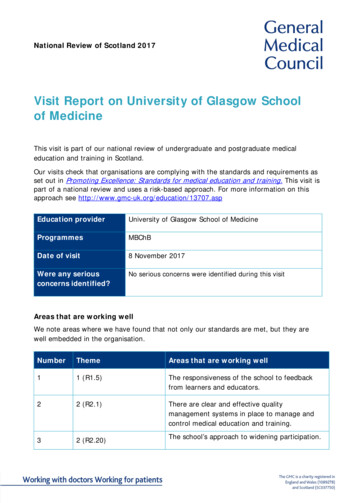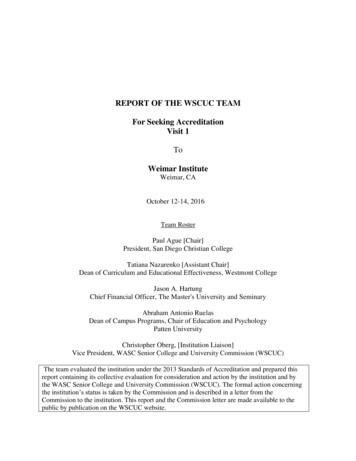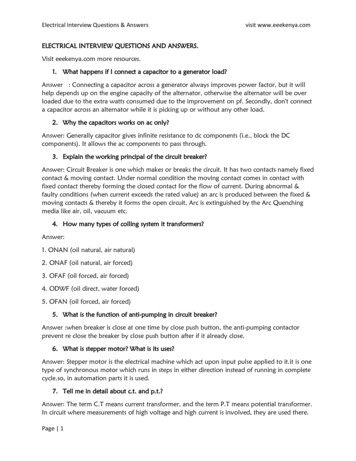
Transcription
National Review of Scotland 2017Visit Report on University of Glasgow Schoolof MedicineThis visit is part of our national review of undergraduate and postgraduate medicaleducation and training in Scotland.Our visits check that organisations are complying with the standards and requirements asset out in Promoting Excellence: Standards for medical education and training. This visit ispart of a national review and uses a risk-based approach. For more information on thisapproach see http://www.gmc-uk.org/education/13707.aspEducation providerUniversity of Glasgow School of MedicineProgrammesMBChBDate of visit8 November 2017Were any seriousconcerns identified?No serious concerns were identified during this visitAreas that are working wellWe note areas where we have found that not only our standards are met, but they arewell embedded in the organisation.NumberThemeAreas that are working well11 (R1.5)The responsiveness of the school to feedbackfrom learners and educators.22 (R2.1)There are clear and effective qualitymanagement systems in place to manage andcontrol medical education and training.32 (R2.20)The school’s approach to widening participation.
45 (R5.3)The curriculum is well planned and demonstratesclearly how students can meet the outcomes forgraduates.55 (R5.3)The choice and range of subjects available forthe student selected components.65 (R5.5, 5.6, 5.7 & 5.8)The school’s assessment strategy that allowsthem to make fair and reliable decisions onmedical student progress.RequirementsWe set requirements where we have found that our standards are not being met. Eachrequirement is: targeted outlines which part of the standard is not being met mapped to evidence gathered during the visit.We will monitor each organisation’s response and will expect evidence that progress isbeing made.NumberThemeRequirementsNo requirements were identified during thisvisitRecommendationsWe set recommendations where we have found areas for improvement related to ourstandards. They highlight areas an organisation should address to improve, in line withbest practice.NumberThemeRecommendations14 (R4.2)The school should monitor time in jobs plansfor undergraduate educators to ensure there issufficient time for educational responsibilities.25 (R5.6)The school should monitor the consistency ofassessments carried out by supervisors.2
FindingsThe findings below reflect evidence gathered in advance of and during our visit, mappedto our standards.Please note that not every requirement within Promoting Excellence is addressed. Wereport on ‘exceptions’, e.g. where things are working particularly well or where there is arisk that standards may not be met.Theme 1: Learning environment and cultureStandardsS1.1 The learning environment is safe for patients and supportive for learners andeducators. The culture is caring, compassionate and provides a good standard of careand experience for patients, carers and families.S1.2 The learning environment and organisational culture value and support educationand training so that learners are able to demonstrate what is expected in Good MedicalPractice and to achieve the learning outcomes required by their curriculum.Raising concerns (R1.1) and Dealing with concerns (R1.2)1The University of Glasgow School of Medicine has clear and understandable processesin place for raising concerns. We met with the student support team who explainedthe ways in which concerns can be raised by students, or identified by the team.Students are surveyed on a regular basis to ensure the team receive regularfeedback, and the team meets with students on placements to obtain feedback.2When concerns are raised these are discussed with the individual by the head of yearand an open discussion takes place. An example was provided of students raisingconcerns about the inconsistency of training they were receiving in different sites forthe same speciality; this led to block leads being appointed to oversee specificspecialities across sites to ensure a consistent approach in exposure to, and thestandard of, training.3Students they are aware of the different ways to raise concerns and are also able todiscuss things informally with tutors and heads of years. Students described theirexperience of using the online tool, ‘Moodle’, to report any concerns. There is a‘student concerns committee’ which meets on a regular basis to discuss sensitiveissues in a small group and feedback to the school.4Students were all aware that there is nominated person at each placement who theycan report concerns to, and all students felt comfortable speaking to seniormanagement at the school to report any concerns.5The school’s management team meet with local education providers 3-4 times peryear to share information and provide feedback, heads of year have strong working3
relationships with local education providers which enables concerns to be raisedimmediately where required.Supporting duty of candour (R1.4)6Students we spoke with were aware of duty of candour and told us that this wasdiscussed regularly and is included in their teaching and discussed on placementswith supervisors.Seeking and responding to feedback (R1.5)Area working well 1: The responsiveness of the school to feedback fromlearners and educators.7All students that we met told us that the school listens to them and is happy toreceive feedback. They provided examples of being invited onto committees to feedinto decisions about the school.8Students in years one, two and three recognised that changes have been made to thecourse based on feedback from previous year groups and they are now seeing thepositive impact of these changes. All students felt the staff were good at explainingwhat action was being taken and how the school is responding to feedback.Induction (R1.13)9The school has recently reviewed all placement induction documentation andprovided feedback to individual placements on how these can be improved.10 We heard that the majority of student inductions to clinical placements were good. Allstudents we met with received induction information prior to starting placements andthe formal induction days for phases four and five are integral in preparing studentsfor their placements.11 Students transferring from St. Andrews receive a short but adequate induction andfeel well supported, they are offered student mentors to assist with their induction tothe University and the school.Multiprofessional teamwork and learning (R1.17)12 Students have a good experience of working with pharmacists during theirplacements. However, they felt they would benefit from more experiences whichwould equip them with a better understanding of the roles of nurses and other teammembers.4
Capacity, resources and facilities (R1.19), Accessible technology enhanced and simulationbased learning (R1.20)13 Students recognised the excellent facilities available following the building of the newQueen Elizabeth University Hospital and expressed that there are no longer issueswith computer or Wi-Fi access.14 Students we spoke to commented that there were lots of simulation trainingopportunities available and they were able to be videoed on placements and receivedfeedback on their performance.5
Theme 2: Education governance and leadershipStandardsS2.1 The educational governance system continuously improves the quality andoutcomes of education and training by measuring performance against the standards,demonstrating accountability, and responding when standards are not being met.S2.2 The educational and clinical governance systems are integrated, allowingorganisations to address concerns about patient safety, the standard of care, and thestandard of education and training.S2.3 The educational governance system makes sure that education and training is fairand is based on principles of equality and diversity.Quality management/control systems and processes (R2.1) and Accountability for quality(R2.2) Systems and processes to monitor quality on placements (R2.6)Area working well 2: There are clear and effective quality management systemsin place to manage and control medical education and training.15 Senior management clearly explained the educational governance system that is inplace at the school. They talked through the processes in which the variouscommittees work together, e.g. the assessment committee, learning and teachingcommittee and the executive group. Students are represented on all committees andare able to fully contribute to these committees.16 The school has good quality management process in place for clinical placements anduses feedback received from students to create a traffic light system for rating allareas of placements. This is used to provide feedback on placements whereperformance is improving or regressing and to encourage placements to share goodpractice.17 Students felt that their feedback was valued and used to make positive changes tothe course and their placement experience.18 The school ensures its processes link and feed into wider university processes. Thereis recognition that at times both the school and University are requesting feedbackfrom students at the same time; they are working together to coordinate this andbetter manage the process.Considering impact on learners of policies, systems, processes (R2.3) and Evaluating andreviewing curricula and assessment (R2.4)19 The school’s curriculum has recently been reviewed and amended and this was anopportunity to engage with students and educators both within the school andassociated health boards to improve the curriculum.6
20 Student representatives were included on committees to discuss the curriculumchanges and heads of year hold 2-3 meetings per year for students to providefeedback on the curriculum and other areas. The school has a policy in place thatstates students must be involved in any proposed changes.21 Clinicians involved in educating and supervising students while on placements werealso consulted during the review of the curriculum. Along with ensuring positivechanges to the curriculum the school think that this process has helped re-engagewith a number of clinicians.22 The school told us that they did not engage with patients or members of the publicwhen reviewing the curriculum but are making an effort to engage with these groupsin the future by setting up a patient participation group, and for example discussingfitness to practice processes with them.23 The school has had a clear assessment strategy in place since 2014 and carry outregular assessments focussing on written assessments during the early phases andassessments following each placement block in the later phases.Collecting, analysing and using data on quality and on equality and diversity (R2.5)24 The school told us about the work they are doing on collecting and analysing equalityand diversity data. This work is focussing on the retention rates and re-sits rates forstudents and further investigation is being carried out to look into specific aspects ofthis information.Sharing information of learners between organisations (R2.17)25 The school has a process in place for the transfer of information for students joiningfrom St. Andrews School of Medicine. A written transfer is received for each studentand reviewed by the welfare team; any issues that are declared are raised with thehead of year who then discusses these with the student. A yearly teleconference isheld with St. Andrews to discuss progress and share information about thecurriculum.26 The school has developed a process for sharing information with placements byrequesting feedback on performance and attendance prior to the end of eachplacement as this allows them the opportunity to discuss any concerns with thestudents or their supervisor before the start of the next placement.Recruitment, selection and appointment of learners and educators (R2.20)Area working well 3: The school’s approach to widening participation.27 The school has a number of programmes in place to widen participation and is doingsome excellent work in this area with over 20% of their students falling into this7
category. Initiatives include: a university wide REACH programme that the school ispart of, summer schools to help upskill potential students, lower entry requirements,and the Glasgow access programme. There is also a pre-medical school course that isrun and guarantees a place in the Medical School if the students pass the writtenassessments.28 The school is meeting the Scottish Government’s requirements for wideningparticipation but still want to increase their numbers and continue to explore furtherways of doing this.8
Theme 3: Supporting learnersStandardS3.1 Learners receive educational and pastoral support to be able to demonstrate whatis expected in Good Medical Practice and achieve the learning outcomes required by theircurriculum.Good Medical Practice and ethical concerns (R3.1)29 The school has recently appointed a new director of professionalism who will beresponsible for ensuring students are made aware of all university and school policies,GMC standards and updates, and the fitness to practise process. The Medical Schoolis currently working with the Dental School to produce a new module that will includespecific lectures on professionalism.30 Students are made aware of the fitness to practise policy and procedure. If a referralis raised about a student this would be referred to the head of year and head ofschool and they would try to deal with this at a local level. If they felt the concerncould not be dealt with at a local level then they can make the decision to refer thisinto the fitness to practice process to be triaged.Learner's health and wellbeing; educational and pastoral support (R3.2)31 Students that we spoke to who transferred from St. Andrews told us that they feelvery well supported when joining the school. They receive a short induction and areoffered student mentors to assist with their induction to the University and MedicalSchool and they are well supported by one of the tutors.32 Students who we spoke to confirmed that staff are friendly and approachable so theywould be happy to raise issues with any of the senior managers if they felt this wasnecessary, they commented that all tutors are quick to reply to e-mails and offersupport when required.Student assistantships and shadowing (R3.6)33 All students receive an induction prior to starting a placement and the majority ofstudents that we spoke to told us that the inductions were good and included all ofthe relevant information.34 The five week ‘Preparation for Practice’ block where the majority of students spendtime at the site where they will be working at the start of foundation year one isappreciated and helps students familiarise themselves with the site and gain anunderstanding of what will be expected of them.9
Information and support about academic opportunities (R3.8)35 The school encourage and support students to self-propose subjects for the StudentSelected Components and students told us that the range of opportunities available isexcellent.36 The school have good exchange programmes in place with Japanese, Australian andSwedish medical schools and are looking to expand this to offer more studentsopportunities to experience health care systems different to the NHS.Out of programme support for medical students (R3.9)37 The student support team told us that the school supports students on electivesmany of whom are overseas. They ensure they have contact details for the studentsand that students have the key contacts for the school, an example was provided of astudent being involved in an incident overseas and this being well managed withgood communication between all of those involved.10
Theme 4: Supporting EducatorsStandardsS4.1 Educators are selected, inducted, trained and appraised to reflect their educationand training responsibilities.S4.2 Educators receive the support, resources and time to meet their education andtraining responsibilities.Time in job plans (R4.2)Recommendation 1: The school should monitor time in jobs plans forundergraduate educators to ensure there is sufficient time for educationalresponsibilities.38 Some clinical educators that we met with felt that they did not have time in their jobplans to deliver education. There are concerns from senior management at the schooland the clinical educators that the time in job plans is not adequate and at times thecurriculum can only be delivered through good will.Educators' concerns or difficulties (R4.4)39 All clinical educators who we spoke to told us they would be happy to raise concernsand were confident that they would be dealt with. They were all happy to providefeedback to students during placements and understood the process for raisingconcerns with the school.40 We heard that there is a system to ensure that a placement provider is aware of anyissues or concerns related to a new student starting a clinical placement, but theprocess could be improved to ensure that this is always done before the studentstarts a placement.11
Theme 5: Developing and implementing curricula and assessmentsStandardS5.1 Medical School curricula and assessments are developed and implemented so thatmedical students are able to achieve the learning outcomes required by graduates.S5.2 Postgraduate curricula and assessments are implemented so that doctors in trainingare able to demonstrate what is expected in Good Medical Practice and to achieve thelearning outcomes required by their curriculum.GMC outcomes for graduates (R5.1)41 The students that we spoke to told us that they were aware of what they needed tolearn and the learning outcomes for each placement and each year.42 Students understand what assessments they must complete prior to each placementand were happy that there would be no problem with finding the opportunity tocomplete these.Informing curricular development (R5.2)43 The school has recently reviewed and developed the curriculum and students werefully involved in this through representation on committees and meetings with yearheads.Undergraduate curricular design (R5.3)Area working well 4: The curriculum is well planned and demonstrates clearlyhow students can meet the outcomes for graduates.Area working well 5: The choice and range of subjects available for the studentselected components.44 Students that we met told us that the curriculum was good and provided them with avariety of experience. They gain a variety of experience by spending half of theirplacement time in Glasgow and half of their time in rural areas.45 Students appreciated the early clinical exposure they receive in year one and felt thatthis added to their experience and they enjoyed not having to wait until later yearsfor this exposure.46 The range and availability of the student selected learning components is excellentand provides students with an extensive range when choosing their own areas oflearning. Students are encouraged to propose their own options and that this is wellsupported by tutors and gives students the opportunity to focus on areas of interestand specific specialities.12
Assessing GMC outcomes for graduates (R5.5), Fair, reliable and valid assessments (R5.6),Mapping assessments against curricula (R5.7) and Examiners and assessors (R5.8)Area working well 6: The school’s assessment strategy that allows them tomake fair and reliable decisions on medical student progress.47 The school has a clear assessment strategy in place and carry out regularassessments focussing on written assessments during the early phases andassessments following each placement block in the later phases.Recommendation 2: The school should monitor the consistency of assessmentscarried out by supervisors.48 All students we spoke to told us that they were aware of their assessments and arehappy that the majority of these are fair; however some students did raise concernsabout
experience of using the online tool, ‘Moodle’, to report any concerns. There is a ‘student concerns committee’ which meets on a regular basis to discuss sensitive issues in a small group and feedback to the school. 4. Students were all aware











